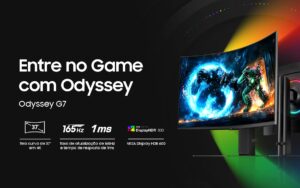
During Computex 2024, Adata revealed its latest venture into the competitive portable gaming PC market with the launch of the XPG Nia. The company is yet another that is venturing into this segment, and brings new innovations.
The XPG Nia stands out for being the first in the industry to offer upgradable RAM and storage, a feature that could attract many gamers looking for flexibility and improved performance in their devices.
Read too:
Zone: this is Zotac’s portable console with a 7-inch screen and Ryzen 7 8840U
ASUS ROG Ally X launches with exciting updates for the portable console market
XPG Nia innovations and differences
Adata brought a significant difference to the market with the XPG Nia, offering expandable memory up to 64GB using the new CAMM2 format modules, which were also widely discussed at this year’s Computex. Although Nia’s initial configuration has not yet been released, the possibility of updating ends up becoming a major attraction for users.
In addition to RAM, the XPG Nia’s storage configuration is also flexible. The back panel of the device can be easily removed to access both the RAM and SSD. The portable console includes a single slot for SSDs, similar to competitors, and will come equipped with one of Adata’s own drives, the S55 M.2 2230, with a capacity of up to 2TB.
Another innovation of the XPG Nia is the sliding and tilting screen, which not only improves ergonomics, but also exposes more ventilation outlets, helping to cool the system.

During the demonstration of the device at Computex 2024, it revealed that it comes with Windows 11, and one of the advantages is precisely using the integrated webcam as a biometric security device in conjunction with Windows Hello. Additionally, the camera also enriches the gaming experience with eye tracking, a technology provided by Switzerland-based Eyeware.
According to Adata, another big difference of the XPG Nia is that it is a very ergonomic device, improving comfort during long hours of gaming, in addition to also having a more robust structure, which would be ideal for larger hands of adults. The reclining screen itself and the support that is already built into the device are crucial points in this aspect.

In line with its ‘Circular Computing’ initiative, Adata is making the XPG Nia a practically modular device, meaning it’s very welcoming to modders, as it offers open 3D printing files so users can remodel cases and triggers. This initiative also provides for motherboard upgrades in the future and the reuse of discarded motherboards in other projects, with all specifications, diagrams and pinouts provided by Adata.
In other words, it is a device that can be updated and modified easily, which is one of its main differences.
Price and availability
Although some competitors have already launched devices with AMD Ryzen 8040 (Hawk Point), Adata chose to use Ryzen 7040 (Phoenix) APUs in the XPG Nia. This is due both to the fact that the device is still under development and to Adata’s intention to offer the XPG Nia at an affordable price, between US$500 and US$600 (in direct conversion, it would be around R$2,640 to R$3,160 )
To reach this price point, Adata plans to sell the device directly to consumers and is considering launching a Kickstarter campaign to gauge support and interest in various processor and configuration options.
Fonte: tomshardware
Source: https://www.hardware.com.br/noticias/2024-06/adata-revela-xpg-nia-console-portatil-modular-que-suporta-trocas-e-melhorias.html


